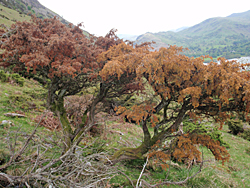 Phytophthora austrocedri is causing widespread mortality of native juniper in Great Britain, especially northern Britain. This project aims to provide the evidence base to guide juniper conservation strategies that mitigate the effects of the pathogen.
Phytophthora austrocedri is causing widespread mortality of native juniper in Great Britain, especially northern Britain. This project aims to provide the evidence base to guide juniper conservation strategies that mitigate the effects of the pathogen.
Research objectives
- Evaluate the genetic diversity of P. austrocedri to determine whether it is a recent introduction to Britain, how long it might have been evolving here, and to elucidate, if possible, whether multiple introductions have occurred.
- Develop a greater understanding of the epidemiology of P. austrocedri by defining optimum conditions for growth and survival and by identifying mechanisms of spread.
- Determine the wider distribution of the pathogen in Britain, linking disease severity with key site factors (soil type, wetness, climate, human activity).
- Determine whether natural resistance occurs in the juniper population, and whether this could be utilised to enable population recovery.
Latest updates
Results so far
Phytophthora austrocedri has very little genetic diversity in Britain and is therefore almost certainly a fairly recent introduction. However, genome-wide differences among British isolates suggest multiple introductions of this lineage, likely via the plant trade. The British linage of the pathogen is genetically and morphologically distinct from the lineage causing widespread mortality of Chilean cedar in Argentina, and the geographical origin of the source population, where both lineages originated, remains unknown.
P. austrocedri grows best at 15°C and is killed at temperatures of 22.5°C and higher. This pathogen is widespread on juniper in many parts of Scotland and northern and southern England, and its DNA is readily detected in soil at infected sites. However, lack of a consistent finding of P. austrocedri DNA in 2m rain traps located on a heavily infected juniper site suggests that the pathogen is not capable of effective aerial dispersal.
It is thought that once the pathogen has been introduced to a site (for example, via supplementary planting of infected stock), it has a slow natural spread in soil, requiring high moisture conditions; thus, juniper populations on wet sites are predisposed to infection. Once established at a site the pathogen can be spread readily in soil locally, vectored by animal movements and/or human activities.
Observations of healthy trees within high-mortality sites suggest that there might be resistance in juniper to P. austrocedri. Inoculation of a clonal trial of rooted cuttings collected from 17 such ‘survivor’ trees showed that many were indeed resistant to the pathogen. A provenance/progeny trial of juniper was established in 2015 with seed collected from 15 geographically separate locations across Britain. The long-term goal of this trial is to assess genetic diversity in juniper and the heritability of resistance to P. austrocedri, which could be exploited to enable population recovery.
Findings of P. austrocedri in the UK plant trade, and its presence in some UK nurseries, raises the risk posed by conservation plantings. A recommendation arising from this research is to avoid supplementary planting of existing juniper sites and instead instigate management actions that optimise natural regeneration.
Our Involvement
Forest Research is leading the project
Publications
Donald, F., Green, S., Searle, K., Cunniffe, N.K., Purse, B. 2020. Small scale variability in soil moisture drives infection of vulnerable juniper populations by invasive forest pathogen. (PDF-2.5MB) Forest Ecology and Management 473, 118324
Riddell, C.D., Dun, H.F., Elliot, M., Armstrong, A.C., Clark, M., Forster, J., Hedley, P.E., Green, S. 2020. Detection and spread of Phytophthora austrocedri within infected Juniperus communis woodland and diversity of co-associated Phytophthoras as revealed by metabarcoding. (PDF-1.2MB) Forest Pathology
Henricot, B., Pérez-Sierra, A., Armstrong, A., Sharp, P. M., Green, S. 2017. Morphological and genetic analyses of the invasive forest pathogen Phytophthora austrocedri reveal two clonal lineages colonised Britain and Argentina from a common ancestral population. (PDF-850K) Phytopathology 107, 1532-1540.
Green, S., MacAskill, G.A., Dun, H., Armstrong, A.C., Henricot, B. 2016. First report of Phytophthora austrocedri infecting Nootka cypress in Britain New Disease Reports. (PDF-6.3MB) (2016) 33, 21.
Green, S., Elliot, M., Armstrong, A., Hendry, S.J. (2015). Phytophthora austrocedrae emerges as a serious threat to juniper (Juniperus communis) in Britain. (PDF-1MB) Plant Pathology 64, 456-466.
- In collaboration with NERC Centre for Ecology and Hydrology (CEH)
- Funded as part of the Forestry Commission Programme 2 'Understanding Biotic Threats'
- Scottish Forestry
 Phytophthora austrocedri is causing widespread mortality of native juniper in Great Britain, especially northern Britain. This project aims to provide the evidence base to guide juniper conservation strategies that mitigate the effects of the pathogen.
Phytophthora austrocedri is causing widespread mortality of native juniper in Great Britain, especially northern Britain. This project aims to provide the evidence base to guide juniper conservation strategies that mitigate the effects of the pathogen.